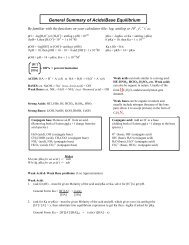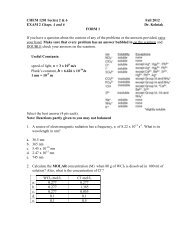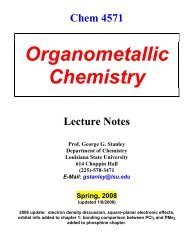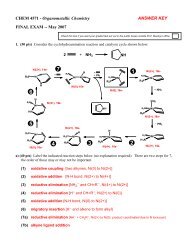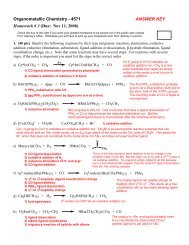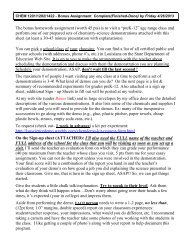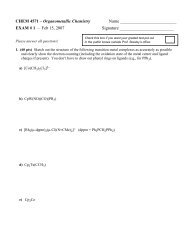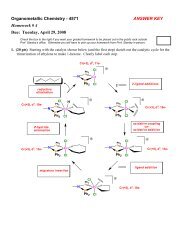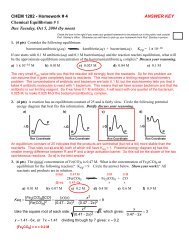Create successful ePaper yourself
Turn your PDF publications into a flip-book with our unique Google optimized e-Paper software.
4<strong>Solution</strong>:Try to remember concepts and not just work by habit or procedure. There are often twospectator ions but some reactions only have one and it is possible for a reaction to have nospectator ions! A spectator ion is an ion that does not change form chemically. To find thecomplete ionic equation break apart the ionic compounds that exist in the aqueous phase.Leave the materials in the s,l,g phases as they are. Do nor break apart molecularcompounds like CO 2 aq because CO 2 is a nonelectrolyte and does not produce ionswhen dissolved in water.Ni s 2H aq 2Cl − aq → Ni 2 aq 2Cl − aq H 2gCompare the reactants and products side of the complete ionic equation for each species.Notice that:2Cl − aq → 2Cl − aqNi s → Ni 2 aq2H aq → H 2gno change chemicallychanges chemicallychanges chemicallyThe only spectator ion is Cl − because this is the only species that doesn’t change formchemically in this reaction. Everything else in this reaction changes form chemically.<strong>Solution</strong>:Cd NO 3aq Li22S aq → CdSs 2LiNO 3aqYou must think about the ion exchange reaction in reverse.a. To find the reactants take the positive ion from CdS and combine with the negativeion from LiNO 3 . You have to think about crossing the charges on the ions in order tofind the correct empirical formulas.Cd 2 combines with NO 3−to give Cd(NO3 ) 25b. Next take the negative ion from CdS and combine with the positive ion from LiNO 3 .You have to think about the charges to get the formulas correct.<strong>Solution</strong>:The balanced molecular equation isLi combines with S 2− to give Li 2SPart 2MgSO 3s 2HCl aq → MgCl 2 aq SO 2g H 2O lTo find the complete ionic equation break up the aqueous species into ions. Leave thesolid, liquid, and gaseous species together.MgSO 3s 2H aq 2Cl − aq → Mg 2 aq 2Cl − aq SO 2g H 2O lThe spectator ions are the species in exactly the same chemical form on both sides of the
6equation. The only spectator ion is Cl − . Remove the spectator ions to find the net ionicequation.MgSO 3aq 2H aq → Mg 2 aq SO 2g H 2O l<strong>Solution</strong>:This is a hard problem. To answer this question you must really understand the propertiesof a spectator ion.a. There are 2 spectator ions.i. A positive ion that goes with CO 32−ii. A negative ion that goes with Pb 2 .b. Spectator ions must exist in the aqueous phase on both the reactant and product sidesof the reaction. In other words, spectator ions cannot form precipitates with any ofthe other ions in the solution. That is the key point to understand.To determine which ions could be spectator ions we must determine what ions can bemixed with CO 3 2− aq and Pb 2 aq and remain soluble. Look at the first choice Ba 2 ,OH − . If we combine Ba 2 with the negative ion CO 3 2− it produces the compound (crossthe charges) BaCO 3 . Look up the solubility rules and you find BaCO 3 is not soluble andso it will be a solid precipitate. This means that Ba 2 could not be a spectator ion becausein the presence of CO 3 2− a solid precipitate is formed. The Ba 2 is not a spectator ionbecause it changes form chemically when it forms the solid precipitate.Ba 2 CO 32−aq → BaCO3 sThe table below shows how all of the given choices combine with the reactants CO 3 2− aqand Pb 2 aq. The solubility rules were used to determine if the product compounds aresoluble or insoluble.Ba 2 ,OH − mixes with CO 3 2− aq,Pb 2 aq to make BaCO 3 s and Pb OH 2sNH 4 ,Cl − mixes with CO 3 2− aq,Pb 2 aq to make NH 4 2 CO 3aq and PbCl 2 sK ,SO 42−mixes with CO 3 2− aq,Pb 2 aq to make K 2 CO 3 aq and PbSO 4 sLi ,ClO 4−mixes with CO 3 2− aq,Pb 2 aq to make Li 2 CO 3 aq and Pb ClO 4 2 aqNa ,O 2− mixes with CO 3 2− aq,Pb 2 aq to make Na 2 CO 3 aq and PbO sLooking at the results we see that the choice Li ,ClO 4 − forms two aqueous products. Sothe ions Li ,ClO 4 − could be spectator ions because they don’t form precipitates whenmixed with CO 3 2− aq,Pb 2 aq.



